Ask Dr. ALOHA: Using CAMEO Tools for RMP and EPCRA Hazard Analyses, Part 1
Using ALOHA to Perform an RMP Worst-Case Consequence Analysis (Fictional Example)
Susan, an environmental consultant, has been asked by the manager of the River City Water Treatment Plant to help make sure that the plant is in compliance with the Risk Management Plan (RMP) rule.
Facilities that are subject to the RMP rule have more than a threshold quantity of a regulated substance and must complete a worst-case consequence analysis. For a toxic substance like chlorine, the analysis considers how far downwind hazardous gas concentrations may extend when the maximum possible amount of chlorine in a vessel or process line is released. For more information, see the Environmental Protection Agency's RMP guidance documents.
Checking Whether the Plant is Subject to the RMP Rule
First, Susan must find out whether the River City Water Treatment Plant falls under the RMP rule. She knows that the plant stores and uses chlorine, which is a regulated substance under the rule. However, the plant is only subject to the rule if the amount of chlorine in any vessel or plant process exceeds the RMP threshold quantity for chlorine, which is 2,500 pounds.
Susan performs an inventory of the plant and finds that two 1-ton tanks of chlorine (liquefied under pressure) are normally kept in an open-walled shed. Both tanks connect to a single line leading into the chlorination unit. Because they're connected to the same line, she considers both tanks to be part of the same process. When the tanks are full, the amount of chlorine in this process is 2 tons (4,000 pounds). This amount is greater than the threshold quantity, so the plant is subject to the RMP rule and must complete a worst-case consequence analysis.
Getting Ready to Make an RMP Worst-Case Consequence Analysis
To perform her analysis, Susan can follow the procedures described in the RMP guidance document or use an air dispersion model that adheres to the parameters listed in the rule. Susan often uses the ALOHA hazard model in her work, so she decides to use it to perform her worst-case consequence analysis. To use ALOHA, Susan will need to use the RMP-specified scenario conditions and determine appropriate values for the additional scenario inputs that the ALOHA model requires.
For an RMP worst-case consequence analysis for a toxic substance, the scenario must use:
- Wind speed of 3.4 miles per hour and F-class atmospheric stability (the most stable). Note that you can use a less stable atmospheric class and/or higher wind speed if those conditions prevailed at all times during the previous three years.
- Highest daily maximum air temperature measured during the past three years and the average humidity at the plant location.
- Urban or rural categories for surface/ground roughness, depending on which best describes the site.
- Ground-level release of the largest quantity of a regulated substance from a vessel or process line failure, including administrative controls.
- Substance's toxic endpoint, which is specified in the rule. For chlorine, the endpoint is 0.0087 milligrams per liter or 3 parts per million. (This value is based on the ERPG-2 for chlorine.)
Susan already knows how she will enter most of these conditions, because ALOHA requires her to enter them whenever she models a scenario. However, ALOHA usually calculates the atmospheric stability class for her, so she isn't sure how to enter F-class stability. After reading the ALOHA help topic on atmospheric stability, though, Susan sees that she has two options: (a) choose scenario conditions (time of day, cloud cover, and wind speed) that will result in F-class stability or (b) force ALOHA to use F-class stability by using the Override button. Susan decides to choose scenario conditions that are appropriate for F-class stability. The table in the stability class help topic shows that F-class stability occurs at night with less than 50% cloud cover (when the wind is 3.4 miles per hour). Now she is ready to start entering information into ALOHA.
Making an RMP Worst-Case Consequence Analysis
Susan starts ALOHA, then chooses River City from the list of locations. Because F-class stability occurs at night, Susan decides to model the release assuming it occurs at midnight. From the SiteData menu, she chooses Date & Time and sets the time, as shown below. Then, from the SetUp menu, Susan chooses Chemical, and selects chlorine from ALOHA's chemical library.
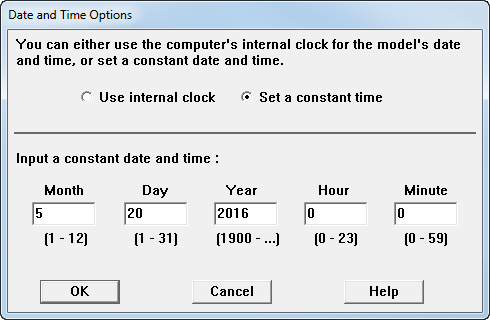
Next, Susan goes to the SetUp menu, selects the Atmospheric submenu, then chooses User Input. The first atmospheric dialog box appears.
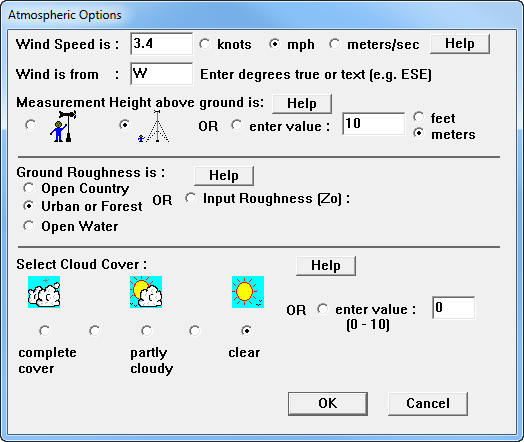
This is how Susan completes the first atmospheric dialog box:
- Wind Speed: 3.4 miles per hour, because it is specified in the RMP rule.
- Wind Direction: West. The direction of the wind doesn't matter in this case (because Susan only needs the distance to the toxic endpoint), so she arbitrarily picks west.
- Wind Measurement Height: 10 meters, because wind speed is typically measured at that height.
- Ground Roughness: Urban or Forest, because the plant is in an urban area. (The rule says to choose either urban or rural, depending on which category best describes the site. Urban is equivalent to ALOHA's Urban or Forest category, and rural is equivalent to ALOHA's Open Country.)
- Cloud Cover: Clear skies. To get the F-class stability conditions that she needs to model, Susan can use any cloud cover value less than 50%, so she decides to use completely clear skies.
When she finishes, a second atmospheric dialog box appears.
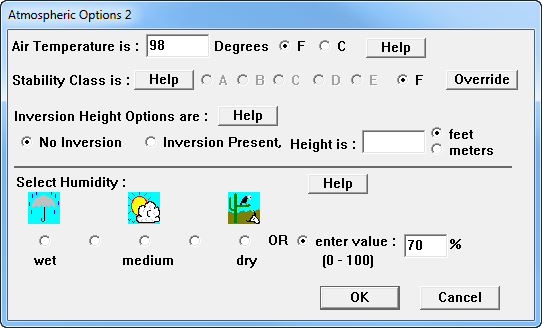
This is how Susan completes the second atmospheric dialog box:
- Air Temperature and Humidity: 98°F and 70% humidity. The rule says to use the highest daily maximum air temperature measured during the past three years and the average humidity at the plant location. Susan contacts the local NOAA National Weather Service office to obtain this information.
- Inversion Height: No Inversion, because the type of low-level inversions that can affect ALOHA's threat estimates are rare.
- Stability Class: Susan notes that her scenario conditions were appropriate and ALOHA has selected F-class stability, so she does not need to override the selection.
Susan is now ready to set the release source. The largest quantity of chlorine in the two connected chlorine tanks is 4,000 pounds. Because there is no passive mitigation system (such as an enclosure around the tanks), the RMP rule says to estimate the release rate of that quantity over a 10-minute period. So, the release rate is 400 pounds per minute (4,000 pounds divided by 10 minutes).
In ALOHA, this release can be modeled using the Direct Source option. From the SetUp menu, Susan selects the Source submenu, then chooses Direct. She fills out the Direct Source dialog box as shown below, then clicks OK.
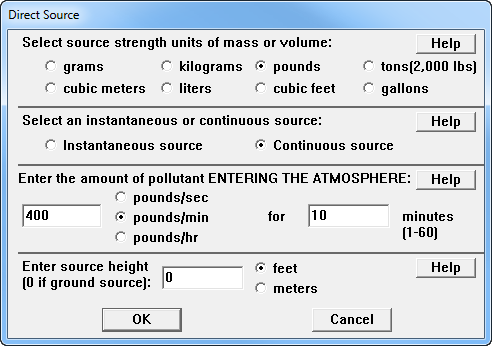
Next, the rule specifies that the model must appropriately account for gas density, which ALOHA does by default. However, just to be sure, she chooses Calculation Options from the SetUp menu and verifies that "Let ALOHA decide" is selected. She knows that when this default option is selected, ALOHA will assess whether a gas is dense (heavier than air) or neutrally buoyant, and will model it accordingly.
Now Susan is ready to obtain the distance to the toxic endpoint specified in the RMP rule. From the Display menu, she chooses Threat Zone. When ALOHA prompts her for Levels of Concern (LOCs), she enters 0.0087 milligrams per liter as the user-specified Orange Threat Zone LOC and sets the other LOCs to None. (Alternately, she could have chosen the ERPG-2 level from ALOHA's list of LOCs for chlorine.) ALOHA displays a threat zone estimate for this worst-case scenario, as shown below.
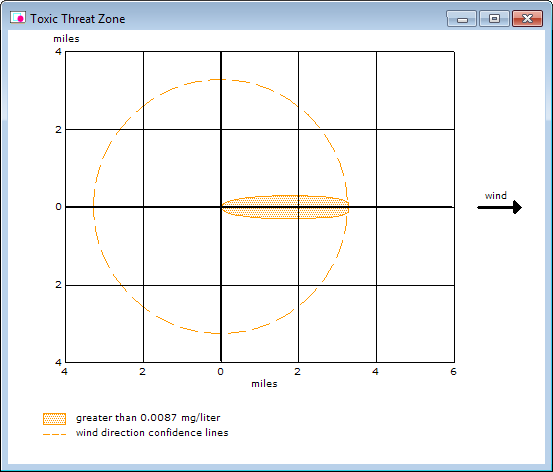
ALOHA predicts a threat zone length of 3.3 miles. The chlorine tanks are 100 yards from the fence around the treatment plant, so Susan can see that in a worst-case release the chlorine concentrations are predicted to exceed the toxic endpoint well beyond the plant's fence.
What is important in an RMP consequence analysis, though, is not finding the distance to the endpoint, but identifying what public receptors (such as neighborhoods, schools, and shopping areas) could be affected by a release. The final step in Susan's analysis is to check in a circle (with a 3.3 mile radius) and centered on the treatment plant to identify the public receptors and environmentally sensitive areas that would be affected by a worst-case release. The RMP rule describes how she should do this.
Susan's next step is to determine if the facility must also complete an alternative consequence analysis to be in compliance with the RMP regulations.
Note: Susan might have encountered ALOHA's threat zone limit if she tried to model a very large release. Because little information about long-range dispersion has been collected—and because ALOHA is designed to model short-term emergency releases as accurately as possible—ALOHA does not estimate dispersion distances more than 6 miles (10 kilometers) from the source. However, to complete an RMP you must report all dispersion distances as numbers—and a "greater than 6 miles" estimate is not valid. If you need to report longer distances, you'll need to use another model, the RMP guidance procedures, or RMP*Comp.
Questions: Contact us with questions, comments, or suggestions about ALOHA.
Go back to the Ask Dr. ALOHA overview.
 An official website of the United States government.
An official website of the United States government. 